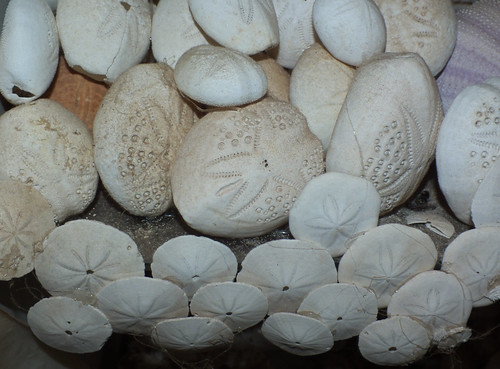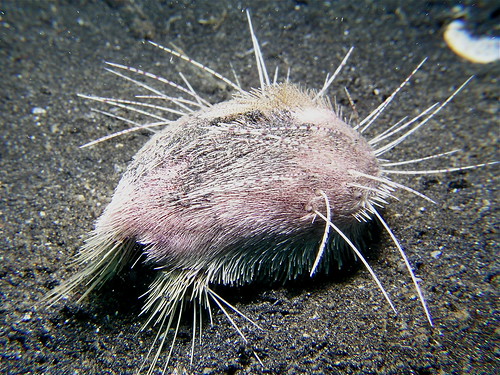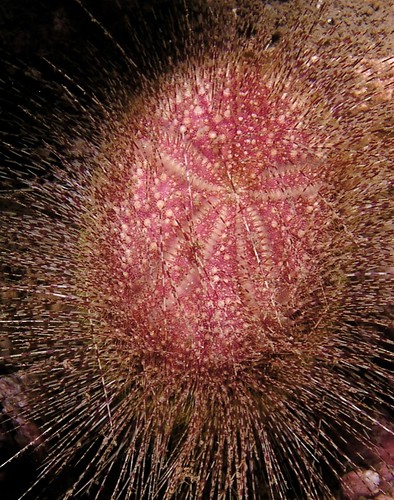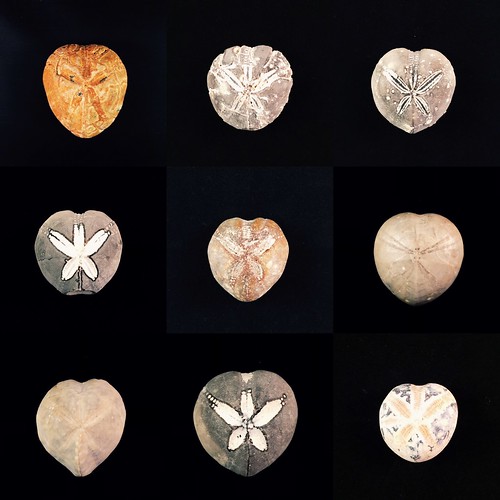Yes urchins, that are shaped LIKE hearts and will burrow their way into yours!!
Heart urchins are in fact what's called "irregular urchins", a subgroup known as spatangoids.. These are sea urchins which DIG into sediments. They are closely related to sand dollars (both of them are considered "irregular urchins"). I've discussed this in detail here. Spines and jaws in these animals are specific adaptations for this life mode.
I've actually written about one of the better known heart urchins, Echinocardium here. Note the name of that genus, Echinocardium which breaks down into its root words Echino for "spiny" and -cardium for "heart."
As I've discussed elsewhere, heart urchins live primarily in sandy or sediment-type bottoms. They occur widely around the world and although most people don't immediately recognize them, they are pretty diverse, about 18 families with many, MANY living species and even more fossils...
They even go by many, many colorful common names "sea potato", "sea eggs", "sea hedgehogs", etc.
Spiny!
When people think of sea urchins, they usually think "spiny ball" and heart urchins are no different! BUT they have urchins that are modified as part of their life style to burrowing/digging through sediment..(as we'll see)
SOME species, such as this Lovenia (top) and the Eurypatagus(?) below have very long and pointy spines most of which you'll notice, are all directed backwards. They would otherwise seem rather ungainly for digging..but these live in shallow-water habitats and the spines, sort of akin to those of a porcupine, seem to aid the animal as defenses...
But the spines can also be used to aid in movement and these urchins move quickly when they want to...
5. They Dig into and eat sediment!
Let's face it, heart urchins are frakkin' adorable. They look like little underwater moles! Here's a nice cartoon of how they live.. basically they love being buried under the sediment/sand and stick their tube feet up out of the top to respire and so forth..
 |
| From Nichols 1959 |
Check out these cool videos of various heart urchin species from Japan and elsewhere... the one with long spines looks like Lovenia..but there's a couple of species and these are found in all of the world's oceans! Southern (Antarctic), Arctic, Atlantic, Indian Ocean, and the Pacific...
4. Bioturbation is important
You don't often SEE heart urchins that often, but that doesn't mean they are unimportant. They are fairly significant bioturbators! i.e. animals that dig through, aerate and mix up the sediment!
NIWA's Drew Lohrer wrote this really nice summary(2003) of the importance of the heart urchin Echinocardium and their primary impact: bioturbation.
Basically, animals that live in sediment, DIG. And their digging imparts an important biological impact: This distributes nutrients, mixes up the sediment allowing oxygen to be transported around, basically leaving the sediment in a place where OTHER animals would be able to use it.
Here's is Lohrer's simple but lovely diagram showing how this works...

4. Bioturbation is important
You don't often SEE heart urchins that often, but that doesn't mean they are unimportant. They are fairly significant bioturbators! i.e. animals that dig through, aerate and mix up the sediment!
NIWA's Drew Lohrer wrote this really nice summary(2003) of the importance of the heart urchin Echinocardium and their primary impact: bioturbation.
Basically, animals that live in sediment, DIG. And their digging imparts an important biological impact: This distributes nutrients, mixes up the sediment allowing oxygen to be transported around, basically leaving the sediment in a place where OTHER animals would be able to use it.
Here's is Lohrer's simple but lovely diagram showing how this works...
3. Heart Urchins were around during the time of the dinosaurs!
As a result of the heart urchin habitat (being buried or mostly so), their skeletons are favorably inclined to be buried and preserved as fossils.
As a result of the heart urchin habitat (being buried or mostly so), their skeletons are favorably inclined to be buried and preserved as fossils.
So, heart urchins occur as far back as the JURASSIC with rich faunas in the Cretaceous. So yes, while big reptiles like Tyrannosaurus and etc. were running around on land? Heart urchins and their relatives were digging and moving around on the seafloor during that SAME time period!!
Heart urchin fossils are VERY informative in the fossil record and a useful model animal for understanding extinction, macroevolution and rates of evolution during that time period.
As a side note: You may also remember a post on heart urchin fossil (genus Micraster) being used as an ornamental around this Late Neolithic (Bronze Age) woman and what looks to be her child found in a tumulus at Dunstable Downs, N. of London. (along with some other folklore pertaining to heart urchins as thunder loaves!)
This article includes the original report with more details, including the two of heart urchin species present: Ananchytes ovatus (now Echinocorys ovatus) and Micraster coranguinum

1. Environmental Indicators!
So, you want to know how animals with "academic interest" have a practical use?? Well, as it turns out Japanese heart urchins, including Spatangus leutkeni, Brisaster latifrons and Echinocardium cordatum were among three species used as indicator species to detect Cesium in and around Fukushima!
These were only a few indicator species of course, the others including sea cucumbers and polychaete worms. BUT these are all part of the infauna..that is the animals which live in the sediment and digest the organic materials from the mud and so forth.
Many infaunal echinoderms were used as part of this, apparently as yet, unpublished study...

Extra! REPRODUCTION! Massive aggregations & spawning video!
And of course, there's SEX. I wrote, wonderingly, about the massive reproductive aggregations of Maretia here. I still don't know much more about it.

Here's a cool video of a heart urchin from Bonaire. So on that note, Happy Valentine's Day if that's your jazz...
So, you want to know how animals with "academic interest" have a practical use?? Well, as it turns out Japanese heart urchins, including Spatangus leutkeni, Brisaster latifrons and Echinocardium cordatum were among three species used as indicator species to detect Cesium in and around Fukushima!
These were only a few indicator species of course, the others including sea cucumbers and polychaete worms. BUT these are all part of the infauna..that is the animals which live in the sediment and digest the organic materials from the mud and so forth.
Many infaunal echinoderms were used as part of this, apparently as yet, unpublished study...

Extra! REPRODUCTION! Massive aggregations & spawning video!
And of course, there's SEX. I wrote, wonderingly, about the massive reproductive aggregations of Maretia here. I still don't know much more about it.

Here's a cool video of a heart urchin from Bonaire. So on that note, Happy Valentine's Day if that's your jazz...








No comments:
Post a Comment